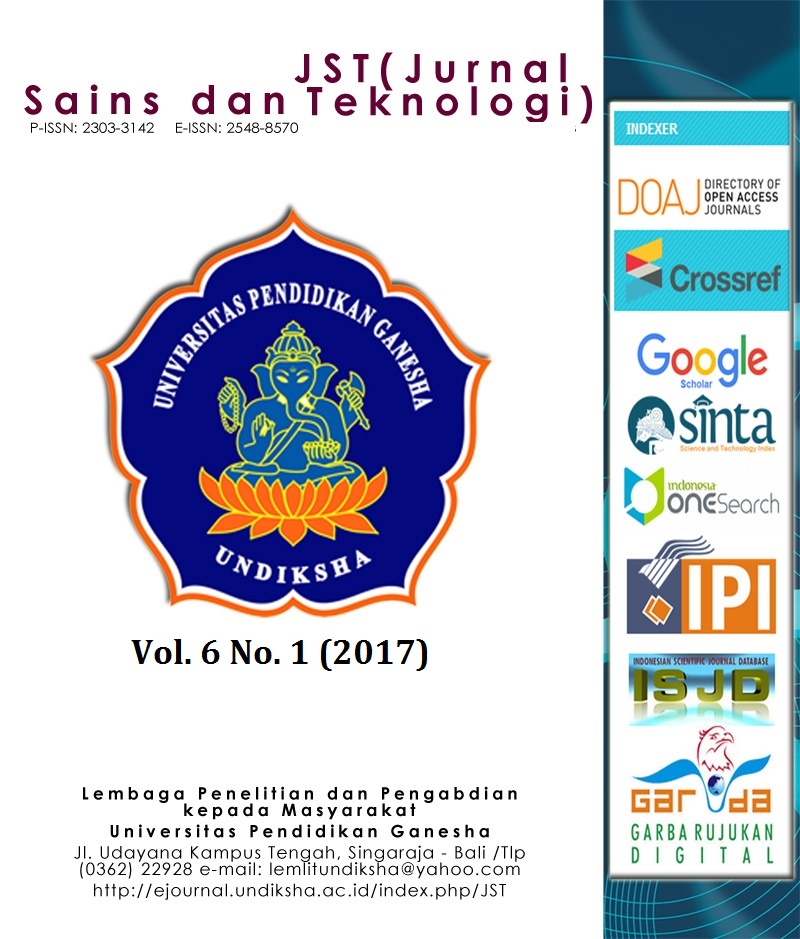MINIMALISASI BIAYA SISTEM DENGAN PEMILIHAN PENGHANTAR JARINGAN DISTRIBUSI MENGGUNAKAN PSO
DOI:
https://doi.org/10.23887/jstundiksha.v6i1.9300Abstract
Particle Swarm Optimization (PSO) digunakan sebagai alat bantu dalam pemilihan tipe penghantar dalam sebuah sistem distribusi tenaga listrik. Penggunaan PSO dalam penelitian ini telah mengalami perubahan dimana pencarian solusi dilakukan dengan cara memasukkan solusi sebelumnya ke dalam inisialisasi partikel selanjutnya. Berdasarkan simulasi yang dilakukan, solusi terbaik dalam pemilihan penghantar diperoleh pada percobaan keempat. Selanjutnya, penghantar dengan luas penampang yang besar tidak selalu mengakibatkan total biaya sistem yang mahal.References
Adebowale, K. O., B. I. Olu-Owolabi, O. O. Olayinka, and O. S. Lawal. 2005. Effect of Heat Moisture Treatment and Annealing On Physicochemical Properties of Red Sorghum Strach. African Jurnal Of Biotechnol. 4(9) : 928-933.
Chayati I, Handayani THW, Nugraheni M, dan Ratnaningsih N. 2008. Teknologi Pengolahan Pati Garut dan Diversifikasi Produk Olahannya Dalam Rangka Peningkatan Ketahanan Pangan. Jurusan Pendidikan Teknik Boga dan Busana. Fakultas Teknik Universitas Negeri Yogyakarta. Yogyakarta.
Collado, L. S. and H. Corke. 1999. Heat Moisture Treatment Effect On Sweet Potato Starches Differing In Amylosa Content. Food Cherm 65 (3): 339-346.
Depdikbud. 1996. Kamus Besar bahasa Indonesia. Jakarta: Balai Pustaka
Djuwardi, A. 2009. Cassava: Solusi Pemberagaman Kemandirian Pangan. Jakarta: Grasindo
Eliasson, A. C. 2004. Starch in Food : Structure, Function, and Application. CRC Press. North America
Haryadi. 2006. Teknologi Pengolahan Beras. UGM Press. Yogyakarta
Histifarina, D. 2002. Kajian Pembuatan Kentang Tumbuk Instan dan Stabilitasnya Selama Penyimpanan. Tesis. Program Pascasarjana Institut Pertanian Bogor. Bogor.
Honestin, T. 2007. Karakterisasi Tepung Ubi Jalar (Ipomoea batatas). Skripsi. Departemen Ilmu dan Teknologi Pangan, Fakultas Teknologi Pertanian, Institut Pertanian Bogor.
Kasuma, N.Y. 2012. Degradasi Senyawa Fenol Pada Limbah Rumah Sakit Secara Fotosintesis dengan Bantuan Katalis Tio. Pasca Sarjana Unand. Padang
Klein, B., Pinto, V.Z., Vanier, N.L.., Zavareze., E.R., Colussi., R., Evangelho, J.A., Gutkosko, L.C, and Dias, A.R.G. 2013. Effect of single and dual heat–moisture treatments on properties ofrice, cassava, and pinhao starches. Carbohydrate Polymers 98, 1578-1584
Koswara, S. 2009. Teknologi Modifikasi Pati. EbookPangan. Available online at tekpan.unimus.ac.id. Diakses pada tanggal 3 Februari 2016.
Koswara, S. 2013. Teknologi Pengolahan Umbi-umbian. Bogor: Southeast Asian Food And Agricultural Science and Technology (SEAFAST) Center Research and Community Service Institution. Bogor Agricultural University.
Kusnandar, F. 2010. 2010. Teknologi Modifikasi Pati dan Aplikasinya di Industri Pangan. A review. Departemen Ilmu Teknologi Pangan, Institut Pertanian Bogor, Bogor
Nahari, I. R. S. 2016. Skripsi Pengaruh Lama Perendaman Dan Konsentrasi Na5P3O10 Terhadap Karakteristik Fisik Dan KimiaMashed Ubi Jalar Instan
Oktavianti, V. C. dan Putri, W. D. R. 2015. Pengaruh Modifikasi Fisik Annealing Terhadap KarakteristikTepung Ubi Jalar Ungu Varietas Ayamurasaki. Jurnal Pangan dan Agroindustri Vol. 3 No 2 p.551-559
Pertiwi A. 2015. Sifat Fungsional dan Amilografi Pati Millet Putih (Pennisetum glaucum) Termodifikasi secara Heat Moisture Treatment dan Annealing. Skripsi. Fakultas Teknologi Industri Pertanian, Universitas Padjadjaran. Sumedang.
Pranoto, Y., Rahmayuni, Haryadi and Rakshit, S. K. 2014. Physicochemical properties of heat moisture treated sweet potato starches of selected Indonesian varieties. International Food Research Journal 21(5): 2031-2038
Putri, W. D. R dan Zubaidah, E. 2015. Karakteristik Fungsional Tepung Sukun Hasil Modifikasi Annealing. JournalProsiding Seminar Agroindustri dan Lokakarya Nasional FKPT-TPI. ISBN:978-602-7998-92-6
Salim, A. R dan Putri, W. D. R. 2015. Pengaruh Suhu dan Lama AnnealingTerhadap Sifat Fisik-KimiaTepung Ubi Jalar Putih Varietas Manohara. Jurnal Pangan dan Agroindustri Vol. 3 No 2 p.602-609
Sandhu, K. S., and Singh, N. 2007. Some properties of corn starches II: physicochemical, gelatinization, retrogradation, pasting and gel textural properties. Food Chemistry, 101, 1499–1507.
Santoso, B. 2010. Karakterisasi sensori, fungsional dan komposisi gizi ubijalar lokal unggulan asal dataran tinggi Wamena, serta kajian formulasi Mashed Sweet Potato. Laporan Penelitian Dikti. Jakarta: Universitas Indonesia
Sun, Q., Wang, T., Xiong, L., Zhao. Y. 2013. The effect of heat moisture treatment on physicochemical properties of early indica rice. Food Chemistry 141, 853–857
Waduge, R. N., Hoover, R., R., Vasanthan, T., Gao, J., dan Li, J. 2006. Effect of annealing on the structure and physicochemical properties of barley starch of varying amylose content, Food Res. Int 39:35-77
Winarno, F. G., 2004. Kimia Pangan dan Gizi. PT Gramedia Pustaka Utama. Jakarta
Zavareze, E. R., and Dias, A. R. G. 2011. Impact of heat–moisture treatment and annealing in starches: A review. Carbohydrate Polymers, 83, 317–328.
Zoumas B. L., L. E. Armstrong., J. R Backstrand., W. L. Chenoweth., P. Chinachoti., B. P. Klein., H. W. Lane., K. S. Marsh., M. Tolvanen. 2002. High-Energy, Nutrient-Dense Emergency Relief Product. Food and Nutrition Board: Institute of Medicine. National Academy Press, Washington, DC.
Downloads
Published
How to Cite
Issue
Section
License
Authors who publish with the Jurnal Sains dan Teknologi (JST) agree to the following terms:
- Authors retain copyright and grant the journal the right of first publication with the work simultaneously licensed under a Creative Commons Attribution License (CC BY-SA 4.0) that allows others to share the work with an acknowledgment of the work's authorship and initial publication in this journal.
- Authors are able to enter into separate, additional contractual arrangements for the non-exclusive distribution of the journal's published version of the work (e.g., post it to an institutional repository or publish it in a book), with an acknowledgment of its initial publication in this journal.
- Authors are permitted and encouraged to post their work online (e.g., in institutional repositories or on their website) prior to and during the submission process, as it can lead to productive exchanges, as well as earlier and greater citation of published work. (See The Effect of Open Access)
















